AMD Athlon 64 Socket AM2 CPU in a Socket 939 Motherboard Result and general impression
1. AMD Athlon 64 Socket AM2 CPU in a Socket 939 Motherboard2. ASRock 939SLI32-eSATA2 PCIe SLI AMD Athlon 64 Socket 939 Motherboard Review3. The technical data and benchmark results4. Result and general impression
Result and general impression
+++ The ASRock 939SLI32-eSATA2 motherboard has a price of approx. 75 Euro (04/2006) and is thus clearly below the so far tested PCIe SLI motherboards.
With the brandnew ULi M1695/ULi M1697 Socket 939 motherboard ASRock shows again, that first-class motherboards do not have to be expensive and can also be suitable for overclocking.
We begin with the equipment, what this ASRock board has to offer. As already mentioned in the recent PCIe SLI (2 PCIe graphics card slots) reviews, most of the SLI motherboards offers (as a result of the standardized ATX form factor) only 2 PCI slots.
But ASRock managed it with the 939SLI32-eSATA2, despite the two PCIe 16x slots for the video cards, to place all the 3 PCI slots. Additional to that this motherboard has a further PCIe 4x slot, a power supply for graphics cards, and a slot for the optional AMD AM2 CPU (940-pin) riser card. Therefor the board layout is not quite optimal, but finally all the connectors are adequate accessible and the layout is absolutely practicable. The area to be left clear around the CPU socket is about 40mm. This is also enough place for large CPU coolers.
On this picture you see the yellow ASRock AM2 CPU slot and the two blank PCIe x16 slots, which don’t need a SLI Mode card. They will be accessed by software only. But of course it’s necessary to connect both video cards with the included SLI-bridge.
Furthermore the board can be equipped with altogether 4 memory modules and is thus upgradeable to maximally 4 GB memory. The allocation for the DUAL Channel memory assembly is mentioned in the user manual and should be followed absolutely.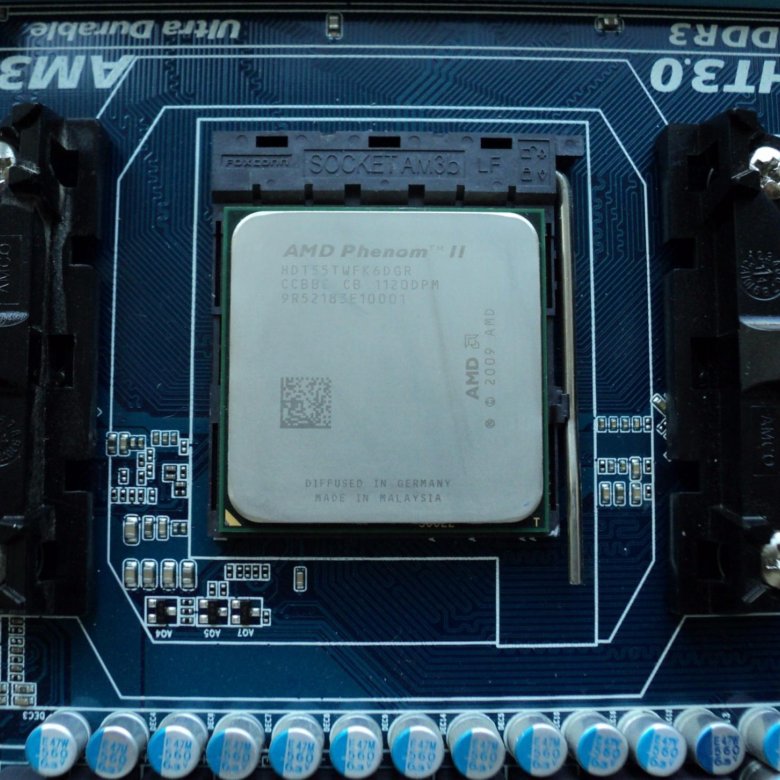 It’s also possible to orientate oneself by the colors of the DDR-Slots.
It’s also possible to orientate oneself by the colors of the DDR-Slots.
Moreover the board offers 2x IDE connectors for up to 4x ATA 133 hard disks, 4x SATA-II ports (RAID 0/1) and 2x eSATA-II ports for external harddisks, which have to be installed at two of the four internal SATA-II ports. Included in delivery is a bootable CDROM and a short guidance for the correct installation of the Serial ATA-II ports. The guidance includes all informations you need to manage a new Microsoft Windows XP installation.
Here’s a picture of the external Serial ATA-II outputs and the internal Serial ATA-II inputs, which have to be connected internal by using the eSATA-II connectors:
In addition the ASRock motherboard has 4x ATX panel USB 2.0 ports, 2 internal USB 2.0 plugs for 4 other optional USB ports and an onboard 10/100/1000 LAN with WoL (Wake on Lan). As soundchip ASRock uses the 6-channel RealTek ALC-660 chip, which is able to give support for up to 6 sound channels with 3x 3.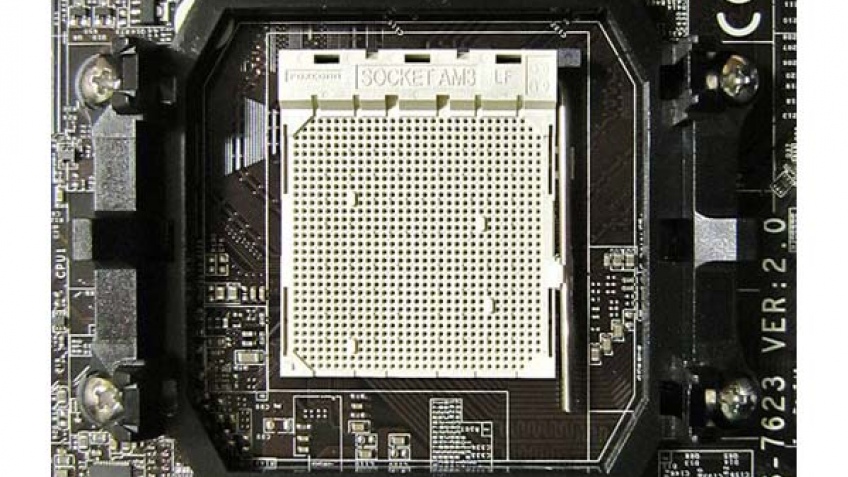 5mm connectors. That isn’t optimal for ambitious gamers, but finally enough for most of the consumers who don’t need digital outputs.
5mm connectors. That isn’t optimal for ambitious gamers, but finally enough for most of the consumers who don’t need digital outputs.
By pressing the F2 key, you get access to the AMI BIOS. Here’re the strengths of the new ASRock 939SLI32-eSATA2 motherboard. In the BIOS menu are e.g. options to change the memory frequency from 133 MHz over 166 MHz up to 200 MHz (divider 3:2/4:3/1:1). The host clock is adjustable from 150 Mhz up to 400 MHz and the HT (hypertransport) frequency from 1x to 5x (200/400/600/800/1000 MHz) beside extensive memory timing. The optional synchronous or asynchronous setting of the CPU/PCIe Bus with a fix PCI clock (33.33 to 37.5MHz is a very helpful feature for good overclocking results.
In the overclocking test it was possible to reach a stable host clock of awesome 300 MHz with the default passive cooled chipset. This is a nice result for an ULi Chipset instead of the usual ~ 270 MHz and this test result was achieved with default chipset voltage. By increasing the chipset voltage this result could be surely improved.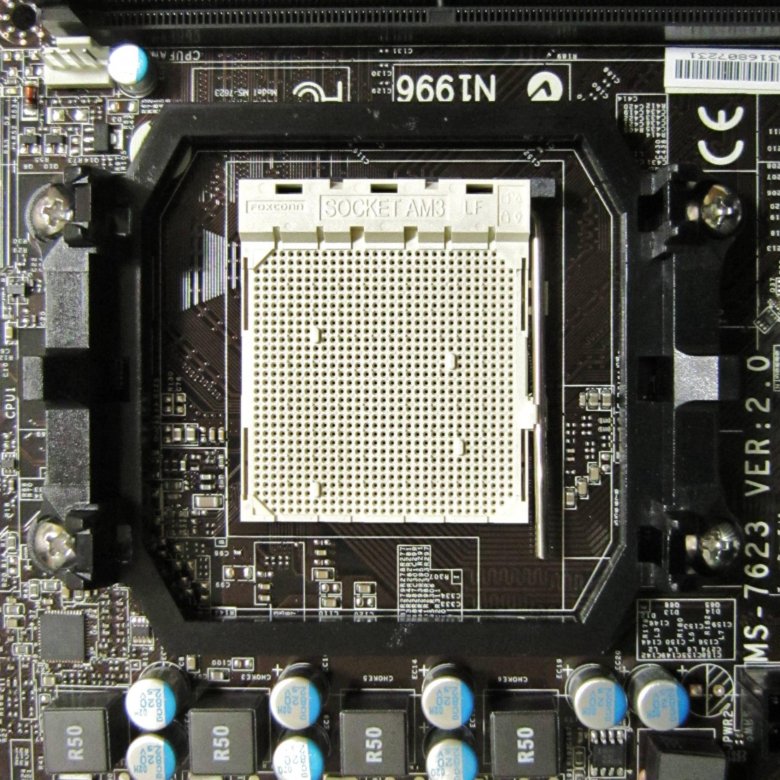 The BIOS setup offers memory voltage (VCCM) and the CPU voltage (VCore) settings, where you can rise the CPU voltage using the new socket 939 pinmod guide.
The BIOS setup offers memory voltage (VCCM) and the CPU voltage (VCore) settings, where you can rise the CPU voltage using the new socket 939 pinmod guide.
Most monitoring values like the CPU temperature, chipset temperature and fan rotation speeds are shown in the BIOS, but it would be nice to have in addition all voltages and the useful “CPU overheat Shutdown” option. According to the manual the CPU is protected against too high temperatures, but in the current BIOS version are no settings to adjust this shutdown temperature.
Result: The very inexpensive ASRock 939SLI32-eSATA2 Socket 939 PCIe SLI motherboard offers among great overclocking results a well basic equipment, lot of upgrade options and a very good performance. In view of the very favourable price the new ASRock motherboard is again unique on the market and offers except of the somewhat poor onBoard sound chip awesome features. In addition the clearly improved overclocking options and results are a neat surprise !
All in all the company ASRock was able to get again the Redaktion ocinside. de Overclocking Price Tip Award (04/2006) for this AMD Socket 939 motherboard, because ASRock shows us once again that we’re able to get more for little money !
de Overclocking Price Tip Award (04/2006) for this AMD Socket 939 motherboard, because ASRock shows us once again that we’re able to get more for little money !
Update of the Review:
An AMD Socket AM2 CPU in an AMD Socket 939 Motherboard won’t work ?
It works ?
As already mentioned in the top of the test, the 939SLI32-eSATA2 Motherboard offers beside the AMD 939 pin CPU socket also a so-called ASRock Future CPU Port (yellow slot). Of course this option shouldn’t remain untested, because who already own this Motherboard and would like to buy now one of the inexpensive AMD AM2 CPUs, can upgrade the board for Socket AM2 within a few minutes!
You just need the so-called AM2CPU board from ASRock and of course the suitable 240-Pin DDR II memory modules, which are set directly on this board. The CPU EZ Upgrade board is currently available for approx. 29 euro (10/2006) and is delivered in this small box:
The box includes the AM2CPU Upgrade board and a manual. The installation is also explained in the manual of the respective ASRock Motherboard and should be carefully noted, because there’re some Jumpers to be changed for the AM2 Future Port.
The installation is also explained in the manual of the respective ASRock Motherboard and should be carefully noted, because there’re some Jumpers to be changed for the AM2 Future Port.
Here’s a picture of the back, with the large unscrewable metal plate of the AM2 Socket.
And in such a way the board looks installed. Install the CPU, the CPU heatsink, the desired DDR-II memory modules, change the Jumper rows on the Motherboard and push the Upgrade board in the ASRock Future CPU Port. According to the manual one should remove the Socket 939 heatsink mounting plate, which wasn’t necessary with the small OEM cooler of the AMD box CPU. The Socket AM2 Upgrade board has by the way its own power connection for the CPU fan and also the additional 12 V power supply plug (4-Pin plug).
A small deficiency became clear however only with the installation. Because hardly video card manufacturer thought about the fact that one could install another card above the PCIe Slot.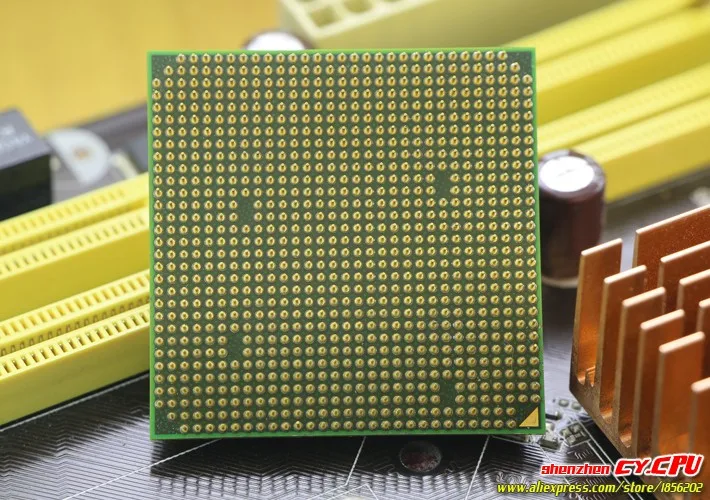 So it may be that the GPU heatsink already hit the Upgrade card. Therefore before the purchase of the Upgrade board it’s recommendable to look at the used graphics card, if there’s a bigger heatsink in diametrical opposition to the PCI Slots.
So it may be that the GPU heatsink already hit the Upgrade card. Therefore before the purchase of the Upgrade board it’s recommendable to look at the used graphics card, if there’s a bigger heatsink in diametrical opposition to the PCI Slots.
After the successful installation, the PC starts now with the new AMD Socket AM2 CPU and in the BIOS is the quite unusual screen with the 940 pin CPU in the 939 pin Motherboard.
Additionally also the DDRII memory is now shown in the BIOS screen. BTW. it’s recommended to download the latest BIOS version immediately, because otherwise “funny” CPU values may appear – e.g. AMD Athlon 64 FX CPU. This is however rather an optical blemish, because the CPU IDs are not implemented in older BIOS versions.
But not only the BIOS post is unusual, also the test results. Because the Motherboard is still very well overclockable and is able to overclock the new AMD AM2 processor and the DDRII memory up to the limit.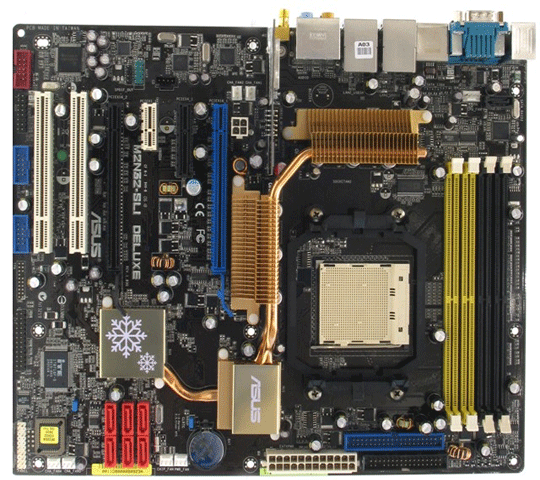 In the test I’ve overclocked for example an inexpensive AMD Athlon 64 3000+ AM2 CPU from 1800 MHz to sayful 2640 MHz !
In the test I’ve overclocked for example an inexpensive AMD Athlon 64 3000+ AM2 CPU from 1800 MHz to sayful 2640 MHz !
The operating system detects the new CPU well and got no errors.
Of course the benchmark difference of the AMD Athlon 64 3000+ Socket 939 CPU compared to the Socket AM2 CPU is also very interesting. Because a comparison of both CPUs on an identical Motherboard is quite rare. Both processors are running with 1800 MHz on 3D Mark 2003. As expected, the AM2 variant got a higher result with the faster memory and reached 8075 3D Mark 03 points instead of the 7916 points with the Socket 939 CPU.
Review Result 2: (ASRock 939SLI32-eSATA2 PCIe SLI Mainboard with AM2CPU Upgrade Board) The excellent ASRock 939SLI32-eSATA2 SLI Mainboard convinces in the test also with that additionally available Socket AM2 Upgrade board. The benchmark results, the stability and even the overclock results are consistently positive and offers the latest Socket AM2 technology for the “old” ?! Socket 939 system. Who like to upgrade an ASRock Socket 939 Motherboard with Future CPU Port to a Socket AM2 System got a nice and reasonable solution with this AM2CPU Upgrade board. Of course it depends on the price if this also make sense for a new AM2 motherboard purchase.
Who like to upgrade an ASRock Socket 939 Motherboard with Future CPU Port to a Socket AM2 System got a nice and reasonable solution with this AM2CPU Upgrade board. Of course it depends on the price if this also make sense for a new AM2 motherboard purchase.
Special thanks to ASRock for their support.
Here you can buy the ASRock motherboard at a favorable price.
**** All Socket 939 motherboard reviews since 01.11.2005 are based on an AMD Athlon 64 3000+ Venice processor, 1x (or SLI systems with 2x) Gigabyte GV-NX66T128VP Nvidia 6600 GT PCI Express video cards and the following software configuration: Microsoft Windows XP SP2, DirectX 9.0c, Forceware 81.85 video driver and 3DMark 2003. All benchmark results should only offer a comparison among themselves for a comparison.
Back to the AMD Athlon 64 Mainboard Review comparison !
<< 1 2 3 4
What Is Socket AM2?
`;
The AMD® socket AM2 is a socket soldered to the motherboard, which allows central processing unit (CPU) hardware to function with the computer. Made as a direct upgrade from the previous socket 754 and socket 939, the socket AM2 — which was replaced by the AM3 in 2009 — had a larger memory-bandwidth-carrying ability. It also featured a midway upgrade called the AM2+, which improved on these features even more. This socket contains 940 pins and, while many earlier CPUs can fit the socket, they will not work. Under the correct conditions, both AM2 and AM2+ can be installed on the same computer and can operate together for powerful computing functionality.
Made as a direct upgrade from the previous socket 754 and socket 939, the socket AM2 — which was replaced by the AM3 in 2009 — had a larger memory-bandwidth-carrying ability. It also featured a midway upgrade called the AM2+, which improved on these features even more. This socket contains 940 pins and, while many earlier CPUs can fit the socket, they will not work. Under the correct conditions, both AM2 and AM2+ can be installed on the same computer and can operate together for powerful computing functionality.
Man holding computer
The socket AM2 came equipped with 940 pinholes, and the CPUs came with the same number of pins. Many of the earlier AMD® CPUs fit this pin configuration but only AM2-specified CPUs will work. This is because the pin configuration is slightly different, so the electrical contacts will not match up and the CPU will be unable to activate.
This is because the pin configuration is slightly different, so the electrical contacts will not match up and the CPU will be unable to activate.
Socket AM2 speeds range from 1.8 gigahertz (GHz) up to 3.6 GHz, with most of the CPUs falling into the middle of this range, around 2.4 or 2.6 GHz. With the AM2+ upgrade, the speed ramped up to anywhere from 2.8 to 4.2 GHz. This socket was made for desktop CPUs and had no mobile CPUs for laptop or mobile computers.
There are six main CPU releases for the AM2 connector. This lineup includes the Athlon 64®, Athlon 64 X2®, Athlon 64 FX®, Opteron®, Sempron®, and the Phenom®. The CPU thickness, depending on the CPU model, ranged from 65 nanometers to 90 nanometers.
This lineup includes the Athlon 64®, Athlon 64 X2®, Athlon 64 FX®, Opteron®, Sempron®, and the Phenom®. The CPU thickness, depending on the CPU model, ranged from 65 nanometers to 90 nanometers.
The socket AM2 received an upgrade, called the AM2+, before the AM3 was released. This new socket increased memory transfer rates and also operated at higher speeds. While the socket is somewhat different, both AM2 and AM2+ can work simultaneously. Operating at the same time can only be done on computer platforms that have the correct basic input output system (BIOS) software for such interoperability.
This socket was intended for high-end users who needed powerful CPUs but did not have the money for more powerful sockets.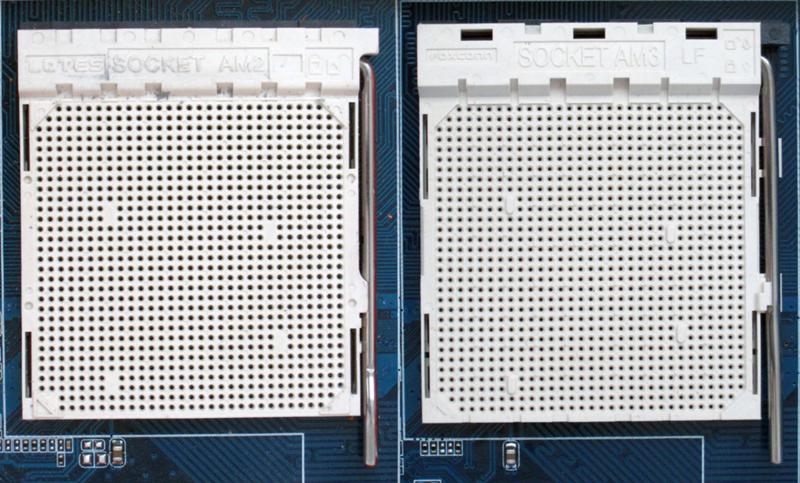 Only desktop CPUs could be used in this socket. If looking for a mobile CPU, the Socket S1 was needed instead, and socket F was needed for servers. Both the AM2 and AM2+ were completely replaced by the socket AM3 in 2009.
Only desktop CPUs could be used in this socket. If looking for a mobile CPU, the Socket S1 was needed instead, and socket F was needed for servers. Both the AM2 and AM2+ were completely replaced by the socket AM3 in 2009.
You might also Like
Recommended
Processors AMD Socket AM2 in the category «Appliances and electronics»
AMD Phenom X3 8450 2.1GHz/2M/95W Socket AM2 / AM2+ Processor for PC HD8450WCJ3BGH
In stock in Kyiv
Delivery in Ukraine
1500
Buy
AMD A6-3400M 1. 4-2.3GHZ/4M/35W SOKKET FS1 Processor for laptop AM3400DDX43GX
4-2.3GHZ/4M/35W SOKKET FS1 Processor for laptop AM3400DDX43GX
in warehouse in Kyiv
Delivery in Ukraine
9000 245 UAH
AMD A10-4600M 2.3— 3.2GHz/4M/35W Socket FS1 (FS1r2) Laptop Processor AM4600DEC44HJ 9Ol000 Kyiv
Delivery in Ukraine
1 299 UAH
Buy
AMD Athlon II X2 220 2.8GHZ/1M/65W SOCKET AM2+/AM3 PC ADX220OCK22GM
in Kyiv
Delivery in Ukraine
145 UAH
350 UAH
Buy
9000 150 UAH
Buy
Terra_byte
AMD A8-4500M processor (4 nuclei) / Socket FS1 (FS1R2) / AM4500DEC44HJ / 1.9 — 2.8 GHz
in Odessa
Delivery 9000 490 UAH 9000 UAH 9000
Buy
Terra_byte
processor AMD Phenom II X3 710, 3 nuclei, 2.6GGC, AM2+, AM3 ST
Delivery in Ukraine
674.53 UAH
519.39 UAH
AMD PHENOM X4 9000 SOKT AM2+ Used (TF)
Delivery from Kyiv
UAH 390
Buy
tera-flops. com.ua
com.ua
Processor AMD Athlon 200GE Socket AM4 (YD200GC6M2OFB) Ends of used (TF) 9030
Delivery in Ukraine
1 550 UAH
Buy
tera-flops.com.ua
RARE POWERFUL AMD processor on Socket am2 for 2 CORE ATHLON 64 X2 6000 89w !!! (2 to 3.1 GHZ !!!)
Delivery in Ukraine
603.9-610 UAH
from 2 sellers
610 UAH
603.90 UAH
Buy
online store «Correct choice»
processor AMD FX 4100 Socket AM3+ (FD4100WMGUSBX) used (TF)
Delivery from Kyiv
450 UAH
Buy
tera-flops.com.ua
See also
AMD Phenom II X3 710 processor, 3 kernel, 2.6GHz, AM2+, AM3 All
Delivery
1 051.73 UAH
22 525.87 UAH
Buy
All-Goods
Coler for the PCCOler E121 III
processor Delivery from Zaporozhye
543 UAH
Buy
Techosvit
AMD Phenom II X3 710, 26GCI, 2.6GTS, 2.6GC AM2+, AM3 ps 9Ol000
Delivery from Kyiv
569. 25-575 UAH
25-575 UAH
from 2 sellers
575 UAH
Buy
Euro-Trada (Lviv and Kyiv)
AMD powerful AMD on 2 nuclei Athlon 64 x2 6000 6000 6000 6000 6000 6000 125W !( 2 to 3.0 Ghz) sam2 am2+ with GARANT 9Ol000 6000 89w!!! (2 to 3.0 GHZ) SAM2 AM2+ 6000+
Delivery from Kyiv
594-600 UAH
from 2 sellers
600 UAH
Buy
eurotechnical training (Lviv and Kyiv)
AMD processor on Socket am2 for 2 CORE ATHLON 64 X2 5200 ( 2 at 2.7 Ghz) sam2 am2+ 5200+ with WARRANTY
Delivery from Kyiv
361.35-365 UAH
from 2 sellers
365 UAH
Buy
euro-train (Lviv and Kyiv)
Top powerful AMD processor on 2 nuclei ATHLON 64 X2 x2 6400 (2 by 3.2 GHZ) SAM2 AM2+ 6400+ SHARANT
Delivery from Kyiv
633.6-640 UAH
from 2 sellers
640 UAH
Buy
Eurotechno-Trad (Lviv and Kyiv)
Processor processor processor AMD A6-4400M | 2.7GHz | Socket FS1 FS1r2 | 2 cores | AM4400DEC23HJ | + Thermal paste! 9Ol000
Delivery in Ukraine
145 UAH
Buy
GameMax Gamma 500 Blue CPU Cooler
Delivery in Ukraine
976 UAH
Shop Online 9 «Comp03» Buy
0002 Processor AMD A10-5750M (Richland, Quad Core, 2. 5-3.5Ghz, 4Mb L2, TDP 35W, Radeon 8650G, Socket FS1r2) 1 904 UAH
5-3.5Ghz, 4Mb L2, TDP 35W, Radeon 8650G, Socket FS1r2) 1 904 UAH
Buy
1000+1 freebie
Processor AMD A8-3520M (Liano, Quad Core, 1.6-2.5Ghz, 4Mb L2, TDP 35W, Radeon HD6620G, Socket FS1) for
Ukraine 1 215 — 1 221 UAH
from 4 sellers
1 215 UAH
Buy
1000+1 free
Processor AMD A4-5000 (Kabini, Quad Core, 1.5Ghz, 2Mb L2, TDP 15W, Radeon HD8330, Socket BGA769 (FT3)) for
Delivery in Ukraine
1 — 1 258 UAH
from 5 sellers
1 159 UAH
Buy
1000+1 freebie
Socket S1: Processors and specifications
What is a socket for a processor?
Socket is a special socket on the motherboard into which the CPU is inserted. This design was created as an alternative to soldering, which greatly simplifies the replacement of the chip and the modernization of the system as a whole. The second advantage is the reduction in the cost of production of mat. fees.
The socket can only work with a certain type of processor. In other words, the contact pads of the various connectors differ significantly. Moreover, the type of fasteners for cooling systems is also often different, which makes almost all sockets incompatible with each other. And now let’s look at AMD sockets by year, starting from the most modern.
In other words, the contact pads of the various connectors differ significantly. Moreover, the type of fasteners for cooling systems is also often different, which makes almost all sockets incompatible with each other. And now let’s look at AMD sockets by year, starting from the most modern.
Installing a processor in socket AM4
What do we need?
Let’s first decide what we need:
- Motherboard with socket AM4. This group includes motherboards based on A350, B350, X370, A450, B450, X470 chipsets, as well as others that will appear in the future.
- A processor compatible with this socket, such as a 1st or 2nd generation AMD Ryzen processor.
- CPU cooler . We use the cooler that comes with the processor.
- Tube of thermal paste.
- Curly screwdriver .
The cooler is usually already covered with thermal paste, but if stored for a long time in a warehouse, it may dry out or may be applied unevenly, so it is better to apply your thermal paste yourself.
Preparing the AM4 socket
Rotate the motherboard so that the rear panel connectors for USB, audio, network, and other components are on the top left. The motherboard socket looks like this:
The MSI B450 Tomahawk has only one latch to secure the processor. It is located at the bottom of the socket. Gently press it, move it down a little and lift it up:
Preparing the processor
Remove the processor from the package, make sure that everything is in order with it and all the contact legs are intact:
There is a golden corner on the case of AMD processors, there is also a dot opposite this corner. This corner is needed so that you can correctly orient the processor to install it in the socket.
Everything is ready, then the actual installation of the Ryzen processor will be performed.
Installing the Ryzen processor into the socket
Rotate the processor so that its gold corner aligns with the upper left corner of the motherboard socket, then gently lower the processor into the socket:
The processor should drop into the socket by itself, without effort.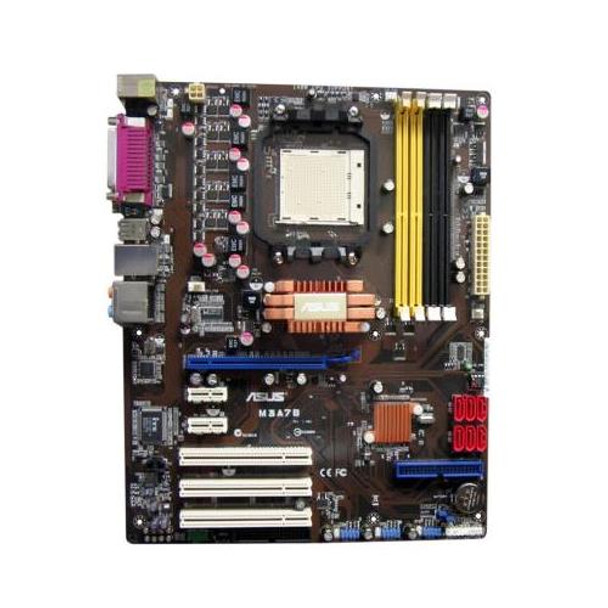 If the processor does not install, then you are doing something wrong. Once the processor is installed, lower the latch.
If the processor does not install, then you are doing something wrong. Once the processor is installed, lower the latch.
Ryzen processor installation in socket AM4 is complete. The only thing left is to install the cooler on AM4, then everything is easier.
Applying Thermal Grease to the Processor
The next step is to apply the thermal paste to the processor. To do this, squeeze a little thermal paste onto the surface of the processor and spread it in a thin even layer over the entire surface of the processor using a special spatula or any piece of plastic.
Installing the cooler on the Ryzen processor
The cooler can be installed in several ways, depending on the build:
- using clamp bolts;
- with a special latch.
The MSI B450 Tomahawk motherboard is equipped with a clip-in cooler. Install the cooler on the processor so that the hooks of the retainers installed on the board match the latch hooks on the cooler, then lower the latch lever.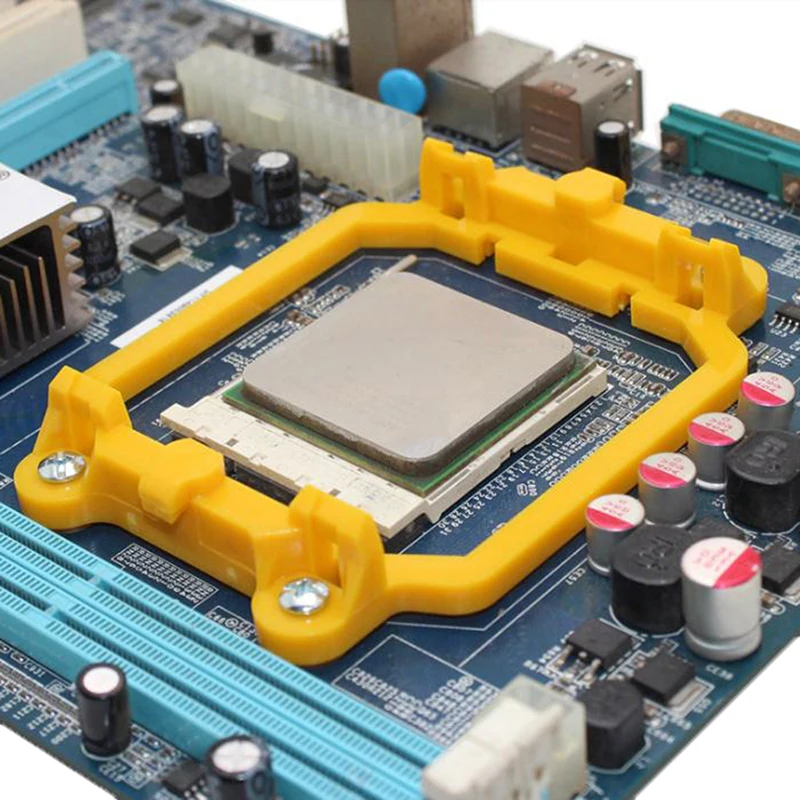
The cooler shipped with the Ryzen 2600X does not have a latch mechanism. It will need to be installed with bolts, so the fasteners for the latch on the board need to be unscrewed:
Next, install the cooler so that the bolt holes in the cooler heatsink case line up with the holes on the motherboard.
Gently tighten the cooler with the bolts, doing one or two turns for each bolt in turn — in order to press everything evenly. It is not necessary to clamp very strongly, it is enough that the heat-removing surface of the cooler fits snugly against the surface of the processor.
Cooler power connection
Next, insert the three-pin power connector of the cooler into the special connector on the motherboard. In our case, on the B450 Tomahawk motherboard, it is located to the right of the processor socket and is signed as CPU_FAN:
Processor power connection
Depending on the motherboard model, the processor can be powered using a 4-, 6- or 8-pin connector. Connect the appropriate power supply wire to the processor power connector on the motherboard:
Connect the appropriate power supply wire to the processor power connector on the motherboard:
Sockets for AMD processors
We provide you with a list of the most current AMD sockets along with a description of the technologies they support. The list consists of the following sockets:
- SP3 socket;
- TR4 socket;
- Socket AM4;
- Socket AM3+;
- Socket AM3;
- Socket AM2+;
- Socket AM2.
Further details about each of them.
Socket SP3
This socket was developed and introduced by AMD relatively recently — in 2021. The socket on motherboards is based on the LGA package, and the socket itself is designed exclusively for server processors of the EPYC line with x86 architecture, made on the Zen microarchitecture. Until 2021, such processors were developed under a different name — Naples. The number of cores and threads in EPYC Naples processors varies from 8 (16) to 32 (64).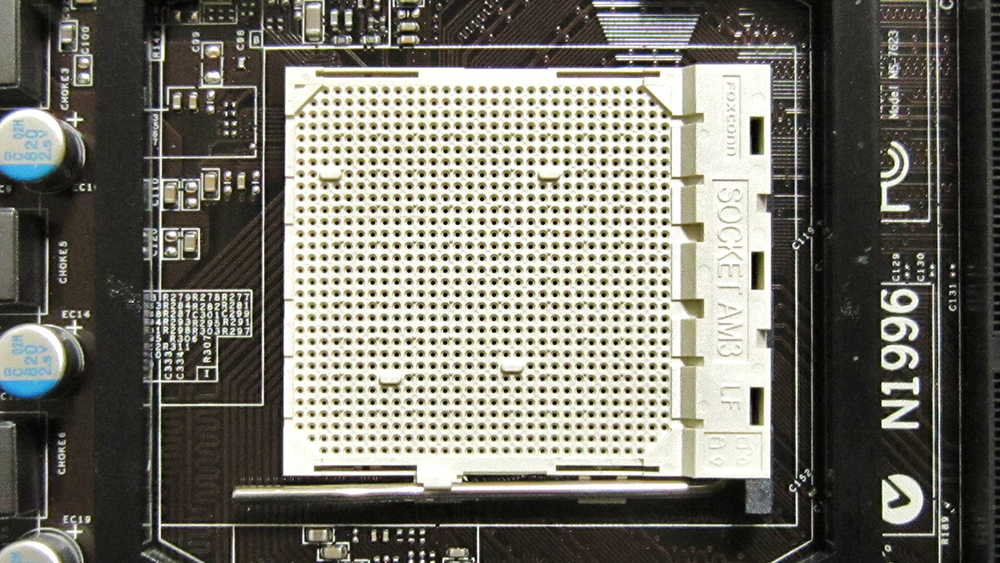 The socket supports RAM up to 2666 MHz.
The socket supports RAM up to 2666 MHz.
A couple of years later, namely in 2021, AMD released a new generation of EPYC processors called Rome. They are based on the newer Zen 2 microarchitecture. There is also support for RAM running at up to 3200 MHz. In addition, a number of processors have significantly increased the number of cores and threads. This value in new processors varies from 8 (16) to 64 (128).
To date, the line of processors for socket SP3 is represented by the following models:
- EPYC Naples: 7601, 7551, 7501, 7451, 7401, 7351, 7301, 7281, 7251, 7551P, 7401P, 7351P;
- Epyc Rome: 7232p, 7302P, 7402P, 7502P, 7702P, 7252, 7262, 7272, 7282, 7302, 7352, 7402, 7452, 7502, 7542, 7552, 7642, 7702, 7742.
- Ryzen Threadripper 1950X, 1920X, 1900X.
- Ryzen Threadripper 2920X, 2950X, 2970WX, 2990WX.
- Ryzen Threadripper 3960X, 3970X, 3980X, 3990X.
- Ryzen 7: PRO 1700X, PRO 1700, 1800X, 1700X, 1700;
- Ryzen 5: PRO 1600, PRO 1500, 1600X, 1600, 1500X, 1400;
- Ryzen 3: PRO 1300, PRO 1200, 1300X, 1200;
- Ryzen 3: PRO 2200GE, 2200GE, PRO 2200G, 2200G;
- Ryzen 5: PRO 2400GE, PRO 2400G, 2400GE, 2400G;
- Athlon: PRO 200GE, 240GE, 220GE, 200GE;
- Ryzen 7: PRO 2700X, PRO 2700, 2700X, 2700X Gold Edition, 2700E, 2700;
- Ryzen 5: PRO 2600, 2600X, 2600E, 2600, 2500X;
- Ryzen 3: 2300X;
- Athlon: PRO 300GE;
- Ryzen 5: PRO 3400GE, PRO 3400G, 3400G;
- Ryzen 3: PRO 3200GE, PRO 3200G, 3200G;
- Ryzen 9: PRO 3900, 3950X, 3900X, 3900;
- Ryzen 7: PRO 3700, 3800X, 3700X;
- Ryzen 5: 3600, 3600X, 3500X, 3500;
- Athlon: 3000G;
- A-12: 9800, 9800E, PRO 9800, PRO 9800E, PRO 8870E;
- A-10: 9700, 9700E, PRO 8770E;
- A-8: 9600, PRO 9600;
- A-6: 9500, 9500E, 9550;
- Athlon: X4 950, 300GE, X4 970, X4 940, 3000G, 240GE, 220GE, 200GE;
- AMD PRO A-series: A12-9800, A12-9800E, A10-9700, A10-9700E APU, A8-9600 APU, A6-9500, A6-9500E, A12-8870, A12-8870E, A10-8770, A10-8770E, A6-8570, A6-8570E, A6-9550, A6-8580, A6-9400;
- FX-9xxx: 9590, 9370;
- FX-8xxx: 8370, 8370E, 8350, 8320, 8320E, 8310, 8300;
- FX-6xxx: 6350, 6300;
- FX-4xxx: 4350, 4330, 4320, 4300.
- Opteron: 3280, 3260, 3250;
- FX-8xxx: 8150, 8140, 8100;
- FX-6xxx: 6200, 6120, 6100;
- FX-4xxx : 4200, 4170, 4130, 4100 Designed with an eye on assembling low cost or high performance systems.
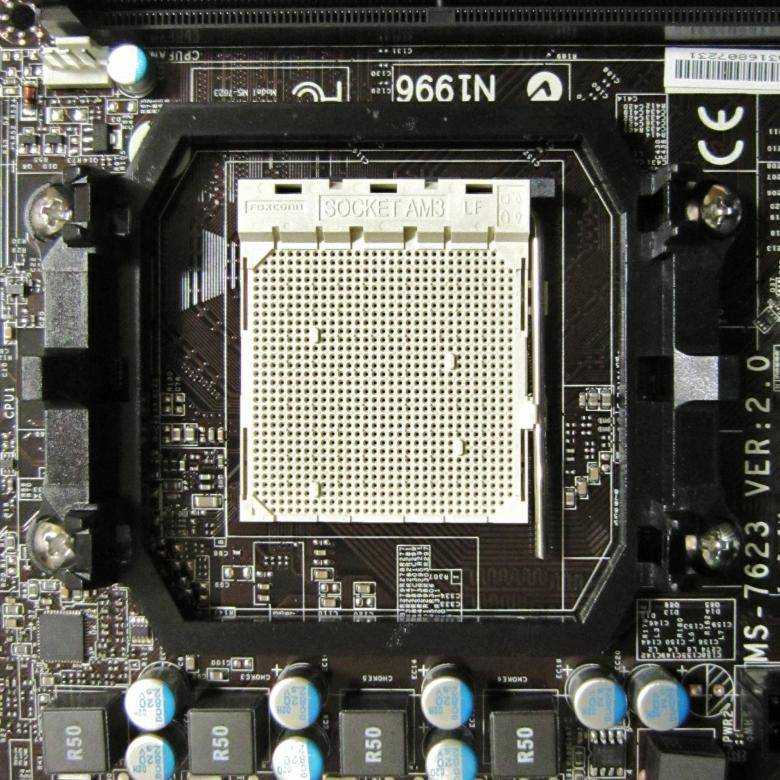 It is a further development of the AM2 socket and differs from its predecessor, first of all, in support for DDR3 memory modules, as well as a higher bandwidth of the HyperTransport bus. The socket is installed in the following motherboards: 890GX, 890FX, 880G, 870.
It is a further development of the AM2 socket and differs from its predecessor, first of all, in support for DDR3 memory modules, as well as a higher bandwidth of the HyperTransport bus. The socket is installed in the following motherboards: 890GX, 890FX, 880G, 870.
All processors released for socket AM3 are fully compatible with socket AM3+ when the PGA pins are identical. To work in newer boards, you will have to reflash the BIOS.
Some chips of the AM2/AM2+ family can also be installed in the socket.
Processors using this socket:
Thuban (45 nm):
- Phenom II X6: 1100T, 1090T, 1065T, 1055T, 1045T, 1035T.
Deneb (45 nm):
- Phenom II X4: 980, 975, 970, 965, 960, 955, 945, 925.910, 900E, 850, 840, 820, 805.
Zosma (45 Nm):
9 X4: 960T.
- Phenom II X3: 740, 720, 710, 705e, 700e.

- Phenom II X2: 570, 565, 560, 550, 545.
- ATH 645, 640, 630, 620, 620s, 610s, 600s.
- Athlon II X3: 460, 450, 445, 435, 425, 420e, 400e.
- Athlon II X2: 280, 270, 265, 260, 255, 250, 245, 240, 240E, 225, 215.
- Athlon II: 170u, 160u;
- Sempron: 190, 180, 145, 140.
- Phenom II X4: 940, 90 9750, 9650, 9600, 9550, 9450s, 9350s, 9150s.
- Phenom X3: 8850, 8750, 8650, 8600, 8450, 8400, 8250e.
As an innovation, it is worth noting the support for DDR2 RAM. The first processors for this socket were single-core Orleans and Manila and dual-core Windsor and Brisbane. This is the last socket in the list of sockets for AMD processors, although there were earlier sockets, but they are already used very rarely.
Processors using this socket:
Windsor (90 nm):
- Athlon 64: FX 62;
- Athlon 64 X2: 6400+, 6000+, 5600+, 5400+, 5000+, 4800+, 4600+, 4200+, 4000+, 3800+, 3600+.
- Sempron LE: 1300. 1250, 1200, 1150, 1100.
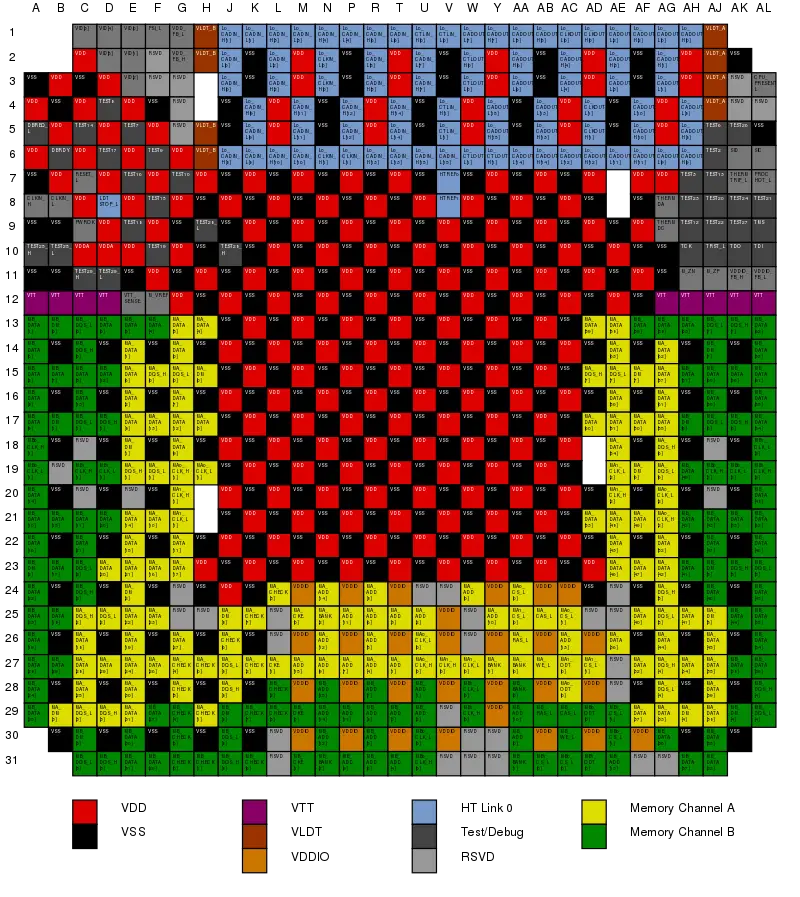
- Manila (90nm):
- Sempron: 3800+, 3600+, 3400+, 3200+, 3000+, 2800+.
AMD FX Processors in Brief
AMD FX is a line of processors that was released by AMD in 2011. These processors were designed for use in work and gaming desktops and competed with second and third generation Intel Core chips. In total, the FX line received 3 different versions, these are 4-core processors with the FX-4xxx index, 6-core ones with the FX-6xxx index and 8-core ones with the FX-8xxx index. Architecturally, AMD FX processors can be divided into two groups, these are Bulldozer architecture chips, which appeared in 2011, and Piediver architecture chips, released in 2012.
One of the features of AMD FX processors is the ability to overclock, which is available for absolutely all models. This is a noticeable advantage against the background of competing Intel Core chips, overclocking of which is possible only with the “K” index. The overclocking potential of the FX also greatly exceeds the capabilities of competitors from Intel Core.
 This well illustrates the world overclocking record that was set on the FX-8350 processor. Under liquid nitrogen, this chip worked at a frequency of 8794.33 MHz. The screenshot below shows a list of the best overclocking results, as you can see there are several chips from the AMD FX line at once.
This well illustrates the world overclocking record that was set on the FX-8350 processor. Under liquid nitrogen, this chip worked at a frequency of 8794.33 MHz. The screenshot below shows a list of the best overclocking results, as you can see there are several chips from the AMD FX line at once. AMD FX processors also have architectural features. Any FX die consists of 4 modules, each of which is a pair of x86 cores that work in tandem. It is in this way that 8-core FX processors are formed, while for the younger 4 and 8-core models, some of the modules are turned off.
Each of the 4 FX Processor Units includes two Integer Units (ALUs) and two Level 1 Cache Units. At the same time, all other blocks specific to x86 processors are common to the entire module. For example, a module has only one instruction decoder, one branch predictor, one floating point unit (FPU), and one level 2 cache array. Due to such architectural features, each individual core is not complete and shares resources with a neighboring core.
 Naturally, this could not have a positive effect on the capabilities, and in many tasks 8-core FX show the performance level characteristic of 4-core processors.
Naturally, this could not have a positive effect on the capabilities, and in many tasks 8-core FX show the performance level characteristic of 4-core processors. Along with the FX processors, AMD also released a new socket — AM3+, which is an improved version of socket AM3. Socket AM3+ socket is backwards compatible with AM3. This means that an AM3-designed processor can be installed on an AM3+ board. Also, in some cases, after updating the BIOS, it is possible to install FX on older boards with an AM3 connector, but in this case there will be problems with the temperature sensor and some other FX functions.
Color coding is used to make the AM3+ socket easily distinguishable from its AM3 predecessor. So AM3 sockets on the boards are always painted white, and AM3 + black. Also socket AM3+ can be distinguished by the inscription «AM3b». More information about AM3 and AM3+ sockets can be found here.
Conclusions
AMD has produced an impressive number of processor architectures over the years.

- Sempron LE: 1300. 1250, 1200, 1150, 1100.
5 SOTETS TRETT
A brand new socket designed by AMD engineers in 2021 for the Threadripper family of processors. Visually similar to SP3, however not compatible with EPYC models. AMD’s first-of-its-kind LGA socket for consumer systems (previously, only PGA versions with «legs» were used).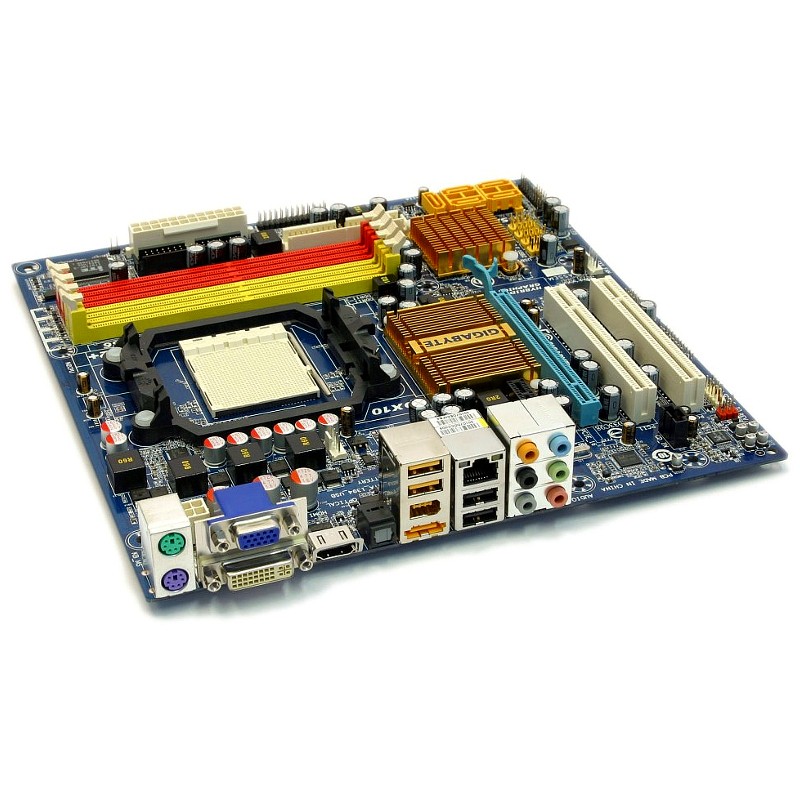
Supports processors with 8-16 physical cores, 4-channel DDR4 memory and 64 PCIe 3.0 lanes (4 of which are X399 chipset).
Processors using this socket:
Whitehaven:
Colfax:
Castle Peak:
Socket AM4
AMD’s best socket was introduced by AMD in 2021 for microprocessors based on the Zen (14nm) architecture. It has 1331 pins for connecting the processor, is the first connector of the company that supports DDR4 RAM. The manufacturer claims that this platform is the same for both high-performance systems without an integrated graphics core, and for future APUs. The socket is installed in the following motherboards: A320, B350, X370.
Among the main advantages, it is worth noting support for up to 24 PCIe 3.![]() 0 lanes, up to 4 DDR4 3200 MHz modules in 2-channel mode, USB 3.0 / 3.1 (natively, not by third-party controllers), NVMe and SATA Express.
0 lanes, up to 4 DDR4 3200 MHz modules in 2-channel mode, USB 3.0 / 3.1 (natively, not by third-party controllers), NVMe and SATA Express.
Processors using this socket:
Summit Ridge (14nm):
Raven Ridge (14 nm):
Pinnacle Ridge (12 nm):
Picasso (12 nm):
Matisse (7nm):
Raven Ridge 2 (14nm):
Bristol Ridge (14 nm):
Socket AM3+
Another name for the socket is Socket 942. In fact, the socket is a modified AM3, developed exclusively for Zambezi processors (that is, familiar to many FX-xxxx) in 2011. Backward compatible with the previous generation of chips, provided that the BIOS is flashed (not supported on all motherboard models).
In fact, the socket is a modified AM3, developed exclusively for Zambezi processors (that is, familiar to many FX-xxxx) in 2011. Backward compatible with the previous generation of chips, provided that the BIOS is flashed (not supported on all motherboard models).
Visually differs from its predecessor in black. Of the features worth noting is the memory management unit, support for up to 14 USB 2.0 ports and 6 SATA 3.0. In parallel with the socket, 3 fresh chipsets were introduced: 970, 990X and 990FX. Also associated with it are the 760G, 770 and RX881.
Processors using this socket:
Vishera (32 nm):
Bulldozer (32 nm):
Heka (45 nm):
Callisto (45 nm):
Propus (45 Nm):
Rena (45 nm):
regor (45 nm):
SARGAS (45 Nm): 45 Nm)
Socket AM2+
This socket was released in 2007. To the smallest detail is similar to its predecessor. Developed for processors built on Kuma, Agena and Toliman cores. All processors belonging to the K10 generation work fine in systems with an AM2 socket, however, in this case, you will have to put up with the “cutting” of the HyperTransport bus frequency to version 2. 0, or even to 1.0.
0, or even to 1.0.
The socket is installed in motherboards with the following chipsets: 790GX, 790FX, 790X, 770,760G.
Processors using this socket:
Deneb (45 Nm):
Toliman (65nm):
